Metode Geographically Weighted Lasso dalam Pemodelan Tingkat Pengangguran Terbuka di Sulawesi Selatan
DOI:
https://doi.org/10.20956/ejsa.v6i1.30863Keywords:
Spatial Heterogeneity, Geographically Weighted Regression (GWR), Multicollinearity, Geographically Weighted Lasso (GWL), Open Unemployment RateAbstract
The Open Unemployment Rate (TPT) in South Sulawesi which reached 6.07% in 2020 has an impact on the economy and welfare levels. TPT data in South Sulawesi has spatial diversity. To overcome spatial diversity in data analysis, the Geographically Weighted Regression (GWR) method can be used. However, GWR is less than optimal if multicollinearity occurs, so the Geographically Weighted Lasso (GWL) method is more appropriate. Research related to GWL on TPT in South Sulawesi has not been conducted. This study aims to obtain a GWL model with a spatial weighting matrix using a fixed exponential kernel weighting function and identify factors that influence TPT. The data used are TPT, population growth rate, literacy rate, illiteracy rate, average length of schooling, job vacancies, and job seekers. The results of the study showed that the factors influencing TPT were population growth rate, illiteracy rate, average length of schooling, and job vacancies in several districts/cities with an R2 value of 89.4%.
References
Fortheringham A, Brusdon C, Charlton M. Geographically Weighted Regression : The Analysis of Spatially Varying Relationships. Englad(GB): Jhon Wiley & Sons, LTD, 2002.
Wheeler, D. Simulatneous Coefficient Penalization and Model Selection in Geographically Weighted Regression : The Geographically Weighted Lasso. Journal of Environment and Planing, 41(3), 722-742, 2009.
Munikah T, Pramoedyo H, Fitriani R. Pemodelan Geographically Weighted Regression dengan Pembobot Fixed Gaussian Kernel pada Data Spasial (Studi Kasus Ketahanan Pangan di Kabupaten Tanah Laut Kalimantan Selatan). Natural B, 2(3), 2014.
Badan Pusat Statistika. Keadaan Ketenagakerjaan Sulawesi Selatan Februari 2020. Sulawesi Selatan: BPS, 2020.
Amalia, E., & Sari, L. K. Analisis Spasial untuk Mengidentifikasi Tingkat Pengangguran Terbuka berdasarkan Kabupaten/Kota di Pulau Jawa Tahun 2017. Indonesian Journal of Statistics and Its Applications. 3(3), 202–215, 2019.
Lestari, S. S. S., Meimela, A., & Revildy, W. D. Analisis Faktor Tingkat Pengangguran Terbuka Dengan Metode Geographically Weighted Lasso. Seminar Nasional Official Statistics, 2020(1), 1286–1293, 2019, doi: https://doi.org/10.34123/semnasoffstat.v2020i1.693
Ningtias, I. P., & Rahayu, S. P. Pemodelan Faktor-faktor yang Mempengaruhi Tingkat Pengangguran Terbuka di Provinsi Jawa Timur Tahun 2015 Menggunakan Regresi Spasial. Jurnal Sains Dan Seni ITS, 6(2), 2015, doi: https://doi.org/10.12962/j23373520.v6i2.24984
Wheeler D, Tiefelsdorf M. Multicollinearity and Correlation Among Local Regression Coefficients in Geographically Weighted Regression. J Geograph Syst 2005(7), 161-187, 2005.
Husila, S. Analisis Pengaruh Inflasi, Rata-Rata Lama Sekolah, Pertumbuhan Ekonomi Terhadap Pengangguran di Provinsi Sulawesi Selatan. Jurnal Ekonomi Dan Pembangunan, 1(23), 2019, doi: http://eprints.unm.ac.id/14350/1/jurnal susi husila.pdf
Anselin L. Spatial Econometrics : Methods and Models, Dordrecht (GB): Kluwer Academic Publisher, 1988.
Downloads
Published
Issue
Section
License
Copyright
It is the author's responsibility to ensure that his or her submitted work does not infringe any existing copyright. Authors should obtain permission to reproduce or adapt copyrighted material and provide evidence of approval upon submitting the final version of a manuscript.


